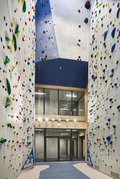Leisure Buildings with Social Relevance
| an article |
by NOW, NEAR, NEXT, |
Leisure facilities and sports buildings are buildings with very high social relevance. Their task is to promote the health and social development of the users. They are sometimes subject to high normative, structural and technical requirements. The bandwidth is enormous and ranges from school sports halls and club halls to swimming pools, multifunctional buildings, stadiums and huge leisure parks.


Hotel Victory, Erding, Germany, Architekturbüro Wund, Friedrichshafen, 2015 / Structural Planning AJG Ingenieure
© Wund GmbH


Seminar building for the Bavarian police, Ainring, Germany, Schwinde Architekten Partnerschaft, 2021 / Structural Planning AJG Ingenieure
© Josefine Unterhauser
In addition to the functional criteria of specific sports, the buildings must meet increasing safety and health requirements. Many existing sports and swimming halls, often more than 40 years old, are waiting for their energy refurbishment - an important contribution to climate protection and sustainability.
The supporting structure is an important design parameter for the large and wide-span buildings - both for new buildings and for refurbishment projects. Depending on the span and area, linear supporting structures, area supporting structures and space supporting structures are used. Not infrequently, these shape the complete appearance of the sports building. In the case of large-volume buildings, supplying the sports area with natural light is a particular challenge and at the same time also an important characteristic of modern sports buildings.
Public spaces can also be actively transformed into leisure and sports spaces to promote people's desire for movement, social interaction and encounters. This potential of urban spaces is increasingly recognised and used in terms of promoting physical activity as part of preventive health care.















